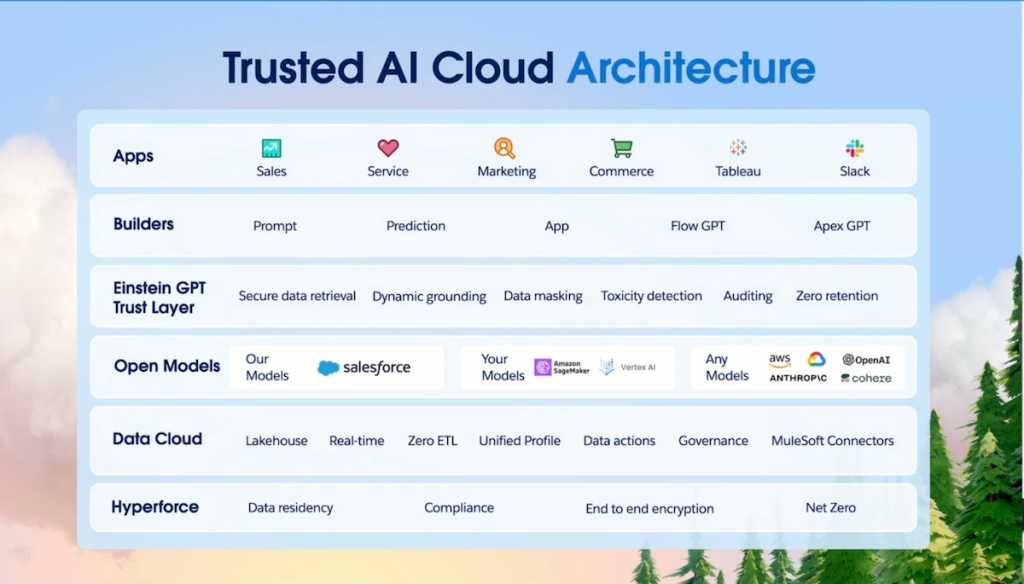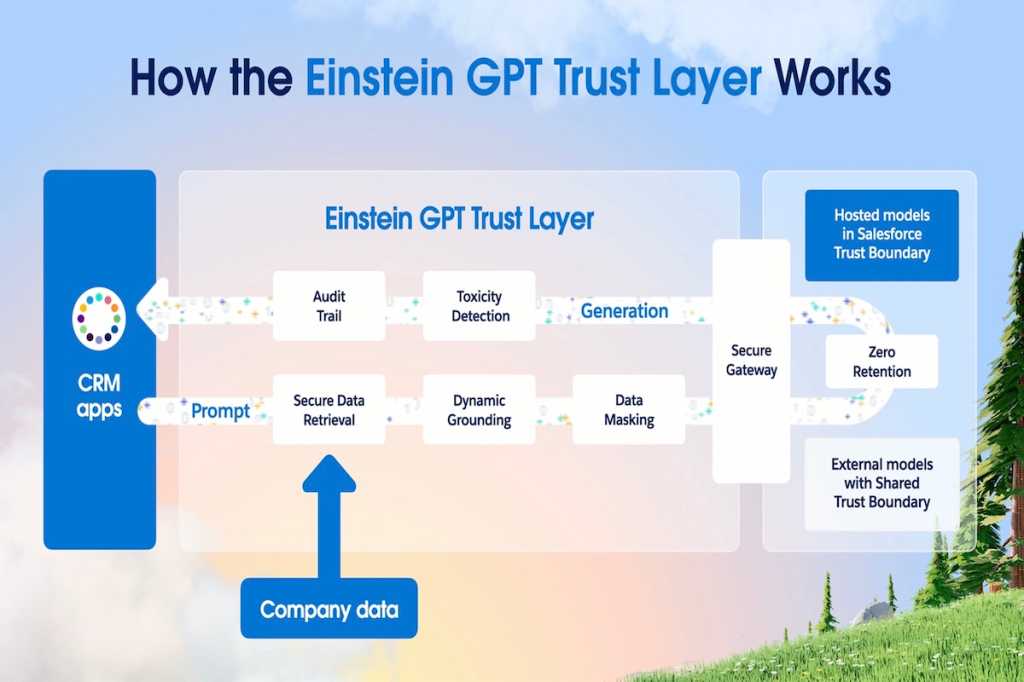Salesforce’s new AI Cloud has left many baffled over what it’s all about — how it is different from the competition, what’s new in the offering, and whether one should consider subscribing. Analysts predict there could only be a few takers for the pricey new offering.
The Salesforce AI Cloud combines the company’s previously announced Slack GPT, Tableau GPT, Apex GPT, MuleSoft GPT, Flow GPT, Service GPT, Marketing GPT, and Commerce GPT along with the new Einstein Trust layer and a prompt engineering tool for training large language models (LLMs).
The new, bundled offering, which focuses on generative AI applications, according to CEO Marc Benioff, is based on the unification of Salesforce’s existing technology stack already offered via products including Einstein GPT, Data Cloud, Tableau, Flow and MuleSoft.
No unified interface for AI Cloud
Although Salesforce is promoting the AI Cloud as a bundled offering via a Cloud Starter Pack, which costs $360,000 annually including a free AI-readiness assessment from Salesforce Professional Services, it does not have a single, unified interface, the company said.
“A lot of the AI cloud will actually manifest as assistants across different cloud offerings that we have, for example, Sales GPT in Sales Cloud, Marketing GPT in Marketing Cloud, and Service GPT in the Service Cloud,” said Jayesh Govindarajan, senior vice president of data science and engineering at Salesforce.
“However, if you are an independent service vendor and you want to create your own prompts, the AI Cloud will offer a separate local console with a low-code experience for training large language models,” Govindarajan said, adding that Salesforce had already signed up with service partners, including Accenture, Deloitte, and PwC.
The AI Cloud’s Starter Pack, according to Forrester principal analyst Liz Herbert, is just one product pricing model that the company is promoting, and “not many Salesforce customers will use that model or will be forced to buy it” as most enterprises already have CRM and other software suites installed.
“If you look at how a typical customer already subscribed to Salesforce, then the bundling is very unlikely to be a common way that someone would buy,” Herbert said, adding that Salesforce was also not very specific on pricing elements for enterprises that want to use just one or more offerings under the AI Cloud. The pricing structure is expected to be aligned, over time, to the usage of the different offerings under the AI Cloud, Herbert said.
Salesforce AI Cloud offers a choice of LLMs
Salesforce’s AI Cloud architecture is built in such a way that it supports multiple LLMs and their training, according to the company.
The AI Cloud architecture is supported by the company’s public cloud infrastructure architecture, Hyperforce, which in turn supports the Data Cloud layer, followed by a layer that hosts multiple LLMs (proprietary or third-party), on top of which resides the company’s new Einstein Trust Layer, the company said.

The Salesforce Trusted AI Cloud architecture consists of multiple layers.
Salesforce
The trust layer separates the Einstein GPT-based generative AI engines — such as Slack GPT, Tableau GPT, Marketing GPT and Commerce GPT — a prompt-engineering tool, and prediction engines, Salesforce said.
The LLMs that the AI Cloud currently offers include third-party models from Amazon Web Services (AWS), Anthropic, and Cohere, among others.
The company has also partnered with OpenAI to use its API for accessing models such as GPT-4, which drive ChatGPT.
Salesforce will also provide its own LLMs, such as CodeGen, COdeT5+, and CodeTF for generative AI implementation in applications, particularly those that aim to increase productivity, bridge the talent gap, and reduce the cost of tech implementation.
A new division, dubbed Salesforce AI Research, has been set up to try to develop new applications for AI by advancing new LLMs or further develop existing ones.
Enterprises, according to Salesforce, can also get their own LLMs trained on their own domain-specific data.
“These models, whether running through Amazon SageMaker or Google’s Vertex AI, will connect directly to AI Cloud through the Einstein GPT Trust Layer. In this scenario, customer data can remain within the customers’ trust boundaries,” the company said.
This isn’t the first time someone has offered these capabilities. Several other prominent technology vendors including AWS and IBM already provide similar offerings in the form of Amazon Bedrock and IBM Watsonx.
How do multiple LLMs work together?
Contrary to practices from some large software vendors that claim to mix different LLMs together to offer generative AI applications, Salesforce’s AI Cloud “chooses the right LLM for the right task,” according to the company.
“The determination of the right LLM is based on outcomes that the system has seen previously,” Govindarajan said, adding that the LLM recommendation engine is learning from the data across all Salesforce deployments.
Giving the example of Marketing GPT creating a landing page, Govindarajan said the system tracks how that landing page has performed, as performance data is also stored inside Salesforce’s Marketing Cloud.
“If the landing page has really worked well, then it will suggest the same LLM it has used to build the landing page to another user who also wants to create a similar landing page,” Govindarajan said.
This same logic is also applied to the multiple flavors of Einstein GPT across different Salesforce Cloud offerings that continuously train the assistants, Salesforce said.
“These generative AI assistants such as Slack GPT or Tableau GPT track if the user ends up following a suggestion. It also tracks the edits or changes to the generated result. This helps it to learn continuously and become more personalized for users,” Govindarajan said.
Einstein GPT Trust layer taps IAM
Salesforce’s Einstein GPT Trust layer is neither new nor differentiated, according to Forrester’s Herbert, who says it follows the same principles that most other vendors are offering in terms of providing security. Like most other vendors, Salesforce uses identity and access management (IAM) rights in the enterprise to safeguard data privacy and security, Salesforce’s Govindarajan said.

Salesforce highlighted security features of its Einstein GPT Trust architecture.
Salesforce
“Once a user runs a query on their system, the technology stack behind these generative AI assistants searches the databases about the attribute that it needs and it has access to, followed by the stack creating a semantic search model based on the knowledge graph of the entire enterprise and the employee requesting the query,” Govindarajan said.
“The retrieved vectorized data is kept within the enterprise’s server, masked, and then fed to the large language model to generate a result or response. So, the stack is essentially copying or imbibing the identity and access management policies that are already existing for that employee,” Govindarajan added.
The Einstein Trust layer’s architecture is also built in such a way that once the query is processed, the information contained in the prompt, or query, is not retained, the company said, adding that the generated result is checked for toxicity and an audit trail log for all prompts is maintained.
Availability
The offerings under the AI Cloud, according to the company, will be made available in different phases, with the Einstein GPT and Service GPT being generally available in June.
The company’s Commerce GPT will be made generally available in July. Other offerings inside the bundle are expected to reach general availability next year after being in pilot for the majority of 2023.
It will be interesting to see how customers react to Salesforce’s new offering, which is more of a bundle of existing offerings than a completely new platform. However, analysts believe that Salesforce AI Cloud will help to enforce more trust in the use of generative AI by enterprises.
“Salesforce recognizes that there are barriers to AI adoption — especially trust. So, they are doubling down on this aspect. The other challenge is that we will have a plethora of LLMs soon — open source, public and private, leading to confusion on which one to deploy. So, Salesforce’s AI Cloud is letting the users plug in the LLM of their choice,” said Sanjeev Mohan, principal analyst at SanjMo.
Artificial Intelligence, Cloud Computing, CRM Systems, Enterprise Applications
Read More from This Article: What is Salesforce AI Cloud: Should you subscribe?
Source: News

